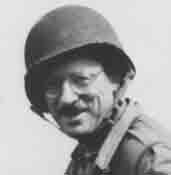Joe Rosenthal
(1911-2006)

“That,” he declares with a proud chortle, “is the greatest photograph of World War II.”
In 1945, Joe Rosenthal was 33, and as an AP photographer assigned to the Pacific theater of the war, Rosenthal had already distinguished himself photographing battles at New Guinea, Hollandia, Guam, Peleliu and Angaur.
Joe Rosenthal took one of the most famous photographs of World War II, but only after both the U.S. Army and the Navy had rejected him as a military photographer because his eyesight was impaired. Rosenthal saw action when The Associated Press sent him to the Pacific.
On February 23, 1945, four days after D-Day at Iwo Jima, Rosenthal was making his daily trek to the island on a Marine landing craft when he heard that a flag was being raised atop Mount Suribachi, a volcano at the southern tip of the island. Marines had been battling for the high ground of Suribachi since their initial landing on Iwo Jima, and now, after suffering terrible losses on the beaches below it, they appeared to be taking it, Upon landing, Rosenthal hurried toward Suribachi, lugging along his bulky Speed Graphic camera, the standard for press photographers at the time. Along the way, he came across two Marine photographers, Pfc. Bob Campbell, shooting still pictures, and Staff Sgt. Bill Genaust, shooting movies. The three men proceeded up the mountain together.
About halfway up, they met four Marines coming down. Among them was Sgt. Lou Lowery, a photographer for Leatherneck magazine, who said the flag had already been raised on the summit. He added that it was worth the climb anyway for the view. Rosenthal and the others decided to continua The first flag, he would later learn, was raised at 10:37 a.m. Shortly thereafter, Marine commanders decided, for reasons still clouded in controversy, to replace it with a larger flag.
At the top, Rosenthal tried to find the Marines who had raised the first flag, figuring he could get a group picture of them beside it. When no one seemed willing or able to tell him where they were, he turned his attention to a group of Marines preparing the second flag to be raised.
“I thought of trying to get a shot of the two flags, one coming down and the other going up, but although this turned out to be a picture Bob Campbell got, I couldn't line it up. Then I decided to get just the one flag going up, and I backed off about 35 feet.
“Here the ground sloped down toward the center of the volcanic crater, and I found that the ground line was in my way. I put my Speed Graphic down and quickly piled up some stones and a Jap sandbag to raise me about two feet (I am only 5 feet 5 inches tall) and I picked up the camera and climbed up on the pile. I decided on a lens setting between f-8 and f-11, and set the speed at 1-400th of a second.
“At this point, 1st Lt. Harold G. Shrier ... stepped between me and the men getting ready to raise the flag. When he moved away, Genaust came across in front of me with his movie camera and then took a position about three feet to my right. 'I'm not in your way, Joe?' he called.
"No,” I shouted, “and there it goes.”
“Out of the corner of my eye, as I had turned toward Genaust, I had seen the men start the flag up. I swung my camera, and shot the scene.”
On Iwo Jima, Rosenthal shot the flag-raising photograph that won the Pulitzer Prize in 1945. The image generated controversy because the now-famous flag was put up to replace a smaller flag. Some argued the event was staged for the benefit of the camera. Repeatedly, Rosenthal explained that it was not.
Rosenthal was born in Washington, DC on October 9, 1911. His parents were Russian Jewish immigrants, but Rosenthal converted to Catholicism. Rosenthal's career in photojournalism began in San Francisco with the Newspaper Enterprise Association. He was chief photographer and manager for Times Wide World Photos before it was taken over by the AP. After the war and after Iwo Jima, Rosenthal became a San Francisco Chronicle staff photographer, where he remained for thirty-five years. Now, close to 90 years old, Rosenthal recalls that day on a tiny atoll in the Pacific where his life became intertwined with a photograph of the raising of a flag. That 1 /400th of a second has lasted his entire life. Rosenthal died on August 20, 2006 at age 94.
Sources: American Jewish Historical Society


